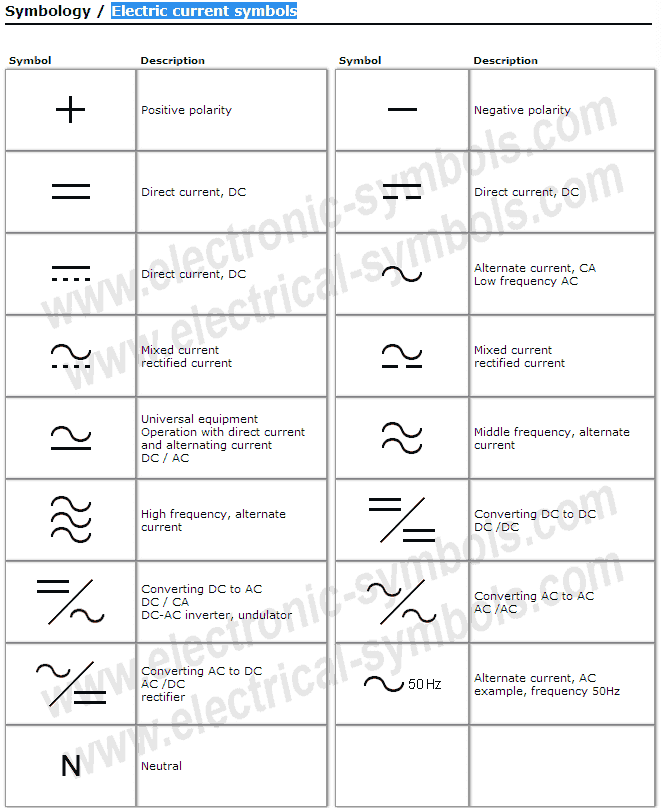DC Volts and AC Volts Symbols Decoded
Ever wondered about those squiggly lines and dashed lines you see next to voltage readings? They're not just random doodles; they represent different types of electrical current: direct current (DC) and alternating current (AC). Understanding these symbols is crucial for anyone working with electronics, from seasoned engineers to curious DIY enthusiasts.
So, what do these symbols actually mean? The symbol for DC voltage is a single straight line or sometimes a straight line with a dashed line underneath. The symbol for AC voltage, on the other hand, is a wavy line, resembling a sine wave. These simple symbols represent fundamental differences in how electricity flows.
But why are there two types of current in the first place? Direct current flows consistently in one direction, like the current from a battery. Alternating current, as the name suggests, periodically reverses its direction. This difference in flow has significant implications for how we use electricity.
Knowing which type of voltage you're dealing with is paramount for safety and proper equipment operation. Applying the wrong type of voltage can damage devices and even pose a safety hazard. Therefore, being able to quickly identify DC and AC symbols is essential.
This article will delve deeper into the world of DC and AC voltage symbols, exploring their history, practical applications, and best practices for working with each type of current. We'll also address common challenges and provide valuable tips for safely and effectively using both DC and AC power.
The concept of DC voltage goes back to the early experiments with electricity, with pioneers like Alessandro Volta developing the first batteries. The symbol for DC likely evolved from schematics representing these early circuits. AC voltage, a later development championed by innovators like Nikola Tesla, utilizes a symbol reflecting the sinusoidal nature of its waveform. These symbols have become standardized over time, allowing for clear communication in electrical diagrams and specifications.
DC voltage is commonly found in batteries, electronics, and solar panels. AC voltage, on the other hand, is the primary form of electricity delivered to our homes and businesses. Recognizing their respective symbols allows us to safely interact with electrical systems.
A simple example of DC voltage is a flashlight powered by batteries. An example of AC voltage is the power supply for your household appliances.
Benefits of understanding these symbols include: safe operation of electrical devices, proper circuit design, and effective troubleshooting.
Before working with any electrical system, always verify the type of voltage using a multimeter. Incorrect assumptions can lead to equipment damage or safety hazards.
Advantages and Disadvantages of DC and AC
| Feature | DC | AC |
|---|---|---|
| Symbol | Straight Line | Wavy Line |
| Flow | Unidirectional | Bidirectional |
| Applications | Batteries, Electronics | Power Transmission, Household Appliances |
Best Practices:
1. Always double-check voltage type before connecting any device.
2. Use appropriate safety equipment when working with electricity.
3. Refer to circuit diagrams for accurate symbol identification.
4. Consult with a qualified electrician for complex electrical work.
5. Ensure proper grounding for all electrical systems.
Real-world examples of DC applications: mobile phones, laptops, and car batteries. AC applications: home lighting, refrigerators, and electric motors.
FAQs:
1. What is the symbol for DC voltage? A straight line or a straight line with a dashed line underneath.
2. What is the symbol for AC voltage? A wavy line.
3. What is the difference between DC and AC? DC flows in one direction, AC reverses direction periodically.
4. Why is it important to know the difference? For safety and proper equipment operation.
5. What is an example of a DC source? A battery.
6. What is an example of an AC source? Wall outlet.
7. How can I measure voltage? Use a multimeter.
8. Where can I learn more about DC and AC? Physics textbooks and online resources.
Tips and tricks: When looking at a power supply, the voltage type is usually clearly marked near the output terminals. Remember to prioritize safety when working with electricity.
In conclusion, understanding the symbols for DC and AC voltage is fundamental for anyone interacting with electrical systems. These seemingly simple symbols represent distinct differences in current flow, with significant implications for safety and equipment operation. From powering our homes to running our smartphones, DC and AC voltage are ubiquitous in our lives. By mastering these symbols and adhering to best practices, we can harness the power of electricity safely and effectively. This knowledge empowers us to make informed decisions about the electrical devices we use and ensures we can troubleshoot and maintain them properly. So, next time you see those squiggly and straight lines, you'll know exactly what they represent and the importance they carry in the world of electricity. Continue learning and exploring the fascinating world of electrical engineering and never underestimate the power of a simple symbol. By understanding the fundamentals, we can appreciate the complexities of the systems that power our modern world.
Crafting winning job offers with ms word templates
Building your dream japanese house in bloxburg
Tricorn black vs iron ore unmasking the differences














